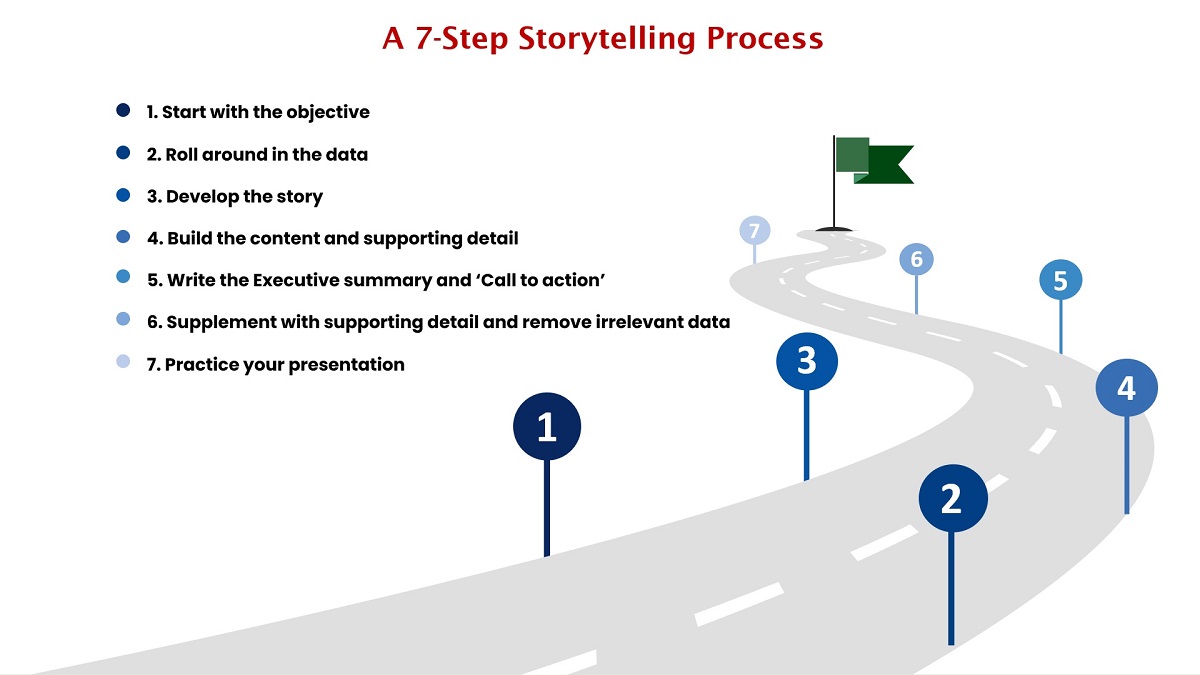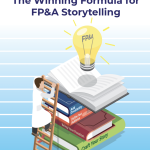In this paper, we lay out the key elements of FP&A storytelling and provide practical guidance...

Data storytelling is a game-changing and differentiating skill for FP&A. It enables FP&A professionals to earn a seat at the decision-making table. We can use our fantastic and unmatched skills to harness data and turn it into insights and actionable business recommendations.
In this article, we will dive into the ‘Why’, the ‘What’, and the ‘How’, culminating in a 7-step process to build and deliver great data-based business stories.
The ‘Why’: The Problem to be Solved
Why is data storytelling important for our profession? FP&A is often included in ‘bean counter’ or ‘back office’ stereotypes, which are frequently putting us behind the scenes. Being able to be a great data storyteller helps shatter these outdated and antiquated stereotypes and puts us where we belong. Squarely at the forefront of the business! Great storytelling engages stakeholders who then want our counsel when faced with significant business decisions.
‘What’ Is Effective Storytelling?
It is important to clearly define what it means to be a great FP&A storyteller. It is not about having a protagonist, a plot, or a villain. It is being able to explain business results, trends and forecasts in a structured way that engages our stakeholders. It is about having the ability to take complex business information and turn it into a simple, purposeful, and structured data-driven narrative.
Data Is Growing at a Faster Rate than Ever Before
The amount of data that businesses have access to is astounding. This represents one of the biggest challenges and opportunities for FP&A professionals. The ability to take vast amounts of complex data and pick out the most relevant data for business leaders is a very important skill. It means we have to discard a lot of data, which is often challenging. Having the ability to do this in short time frames and find the most material data to help tell the story is what we have to strive for.
Why Is Storytelling an Elusive Skill?
FP&A professionals are more comfortable upskilling themselves in technical areas. It should be complemented with a focus on upskilling our soft skills, specifically our data storytelling skills. Like any other skill set, it takes deliberate practice and focus. FP&A professionals should invest at least half of their development time in this skill set.
The ‘How.’ A 7-step Storytelling Process:
Start with the objective
Albert Einstein famously said that if he had an hour to solve a problem, he would spend fifty-five minutes defining the problem. This approach has some truth when it comes to storytelling.
It is critical to clearly define what you are trying to solve and then use this as a compass for the entire process. This includes documenting the objective and reviewing it with stakeholders. It encompasses understanding who your audience is and being clear about your approach. It is important to step back and understand the specific context, stakeholders, time frame and other important elements before you start building the story.
‘Roll around in the data’
Another critical area after the problem definition is spending time with the data and not rushing to build the story and its associated conclusions. This involves developing a structured approach to analysing data.
Starting at fifty thousand feet and then zooming in on the areas that need the most analysis and attention. For example, is revenue the major focus area? Or is it a profit margin?
Once you have gained a clear understanding of what the data is telling you, it is important to apply FP&A analytical techniques. Is a net present value analysis optimal? Or is volume vs rate analysis better? Is a detailed review of product profitability the best fit? Perhaps a combination of techniques is the best approach.
This process that feels slow at the time is critical, and it starts crystallising the story in your mind. Being deliberate with steps one and two ultimately speeds up the process.
Develop the story using storyboarding
At this stage, it is important to write a rough storyline. It should be a structured approach that has a clear throughline and focus. A throughline is a consistent theme present in all parts of the story.
The overall approach should start with the key message(s) and high-level story and then dive deeper into all the supporting content. It is analogous to using an outline to write a book or report. What are the chapters of the book? What is the content? How can analysis be incorporated into the story?
Build the content and supporting detail (using visualisation)
Once the outline is built, it is important to start shaping the content. One critical element of a great story is visualisation. The brain processes visual data significantly faster than text, and retention of visual data is very high. Visual data is also more engaging and interesting.
There is a science to selecting the best visuals. Are you trying to show a comparison, a composition, a part-to-a-whole or a distribution of data? This will help you select what visual to use for each chapter of the story.
Write the Executive summary and ‘Call to action’
The executive summary is one of the most critical steps of a good data-driven story. A great approach for this is to use the headlines of each element of the story as a starting point. In practical terms, when I was building presentations for the CEO and senior leaders within organisations, this was my most important step.
I invested a significant amount of time writing executive summaries, which were condensed versions of the story. They typically fit on a page and tell the story in a structured way. They should end with a ‘call to action’ for the business.
The process of writing the executive summary builds your knowledge of the business and helps tell the story confidently when you have to take the stage.
Supplement with supporting detail and remove irrelevant data
The process of building the executive summary helps us understand where we need to dig in more. For example, if there is a significant variance on one P&L line or product line, it would be appropriate to perform additional analysis and bring additional content into the story. It will show our stakeholders that we know how to focus on the most material areas.
It is also appropriate to put immaterial information into the appendix. Great business stories are to the point and do not have distracting or irrelevant information. A ‘less is more’ strategy is a powerful secret of great storytellers. It helps extremely detail-oriented individuals feel more comfortable.
Practice your presentation (content, body language, voice)
Last but not least, practising verbal delivery of the story and body language is often overlooked. Practising is a critical process that refines your presentation and ensures it is engaging. Finding an accountability partner to critique your story is a technique that great storytellers use. This helps avoid making major mistakes in presentations with senior audiences.
Amy Cuddy’s famous ‘Your Body Language Shapes Who You Are’ TED talk emphasises the importance of using body language. Projecting confidence to stakeholders is almost as important as the story itself.
Conclusions and Recommendation

Figure 1
Effective data storytelling is a game-changing skill set for FP&A! Using this structured 7-step approach and deliberate practice will help you earn a seat at the table. It will lead to great career progression and fulfilment!
This article was first published on the think-cell blog.
Subscribe to
FP&A Trends Digest

We will regularly update you on the latest trends and developments in FP&A. Take the opportunity to have articles written by finance thought leaders delivered directly to your inbox; watch compelling webinars; connect with like-minded professionals; and become a part of our global community.







